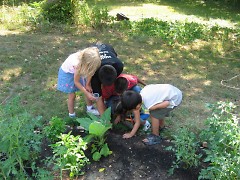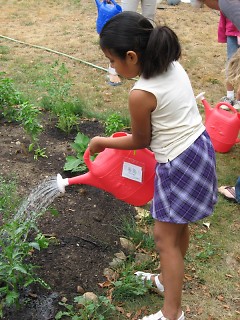Food, food, food
– the topic of food has hit mainstream. Many of us have heard of
the latest food blockbuster, Food Inc., listened to food expert
Michael Pollan on Oprah, or have heard the British super chef Jamie
Oliver, who is looking to remake America's eating habits via the
reality show featured on ABC television.
Food conversation is happening in many circles, and in the past decade in which I've worked in food and community, the tone of the conversation has never been more urgent: we need to change our food system – the way we eat and how it gets to our plate, and we need to do it NOW. Food is woven into the fabric of our human existence and the stakes for change are high: it's our health, our climate, our economies, our cultures.
In the United States, the connection from farm to table has been broken by decades of change in our global food system. The social result of this break in understanding where our food comes from is almost incomprehensible and extremely complex.
With increased global food production, cities have become detached from local farms and food resources. In turn, local farms have been separated from the urban community and they struggle to find alternative ways to sell their produce locally rather than corporately over long distances. Michigan farmers alone continually try to remain competitive in a global agricultural market, and many small farmers are re-creating the food system so they may have economically-viable, small scale production farms within local markets.
Urban residents may not have access to a diverse range of fruits and vegetables at an affordable price, and supermarkets that are increasingly built on the periphery of town make regular access to fresh fruit and vegetables difficult to those living in the city. Often, this lack of access to nutritionally-sound food in urban areas contributes to poverty-related poor health.
Fortunately, Grand Rapids has a strong cadre of food activists who have created a community food coalition, working to increase access to fresh foods within the urban community through a myriad of channels – community gardens, urban farms, food cooperatives, a more effective pantry system – to name a few. Most recently; Grand Rapids has a proposal for a four season urban market, which has tremendous implications for both consumers and producers alike and can result in an increase in access to fresh foods year-round if the proposal moves off the drawing board.
And then there is the other side of the same coin – many kinds of food are always available in the suburban supermarket, and often our children no longer understand the seasons in which food is grown. The package foods industry has made it possible to afford and prepare processed foods easily; not to mention the impact of the use, marketing and availability of heavily processed food products on their perceptions of a healthy diet. Cartoon Network, anyone?
So it's no wonder that our children rarely make the connection between their health and the importance of fresh vegetables and foods.
While our food (production and consumption) system continues in this manner, our society faces a myriad of challenges. Of course, one of the greatest challenges is the health crisis of childhood obesity. Obesity is a multi-faceted issue: children are overweight because of their sedentary lifestyle and they are also overweight because they do not have a healthy relationship with food, or adequate access to whole foods.
But ironically, our children are not only overweight, they are also severely malnourished. I am not speaking of physical malnourishment due to the rampant poverty that affects children in urban and rural communities—although it is a factor. Children of all socioeconomic status are hungry for more. They are hungry for more than the empty-calorie foods that can be found at the local convenience store or in the vending machine in the hallway at the local middle school.
Our children are starving for a sense of community, family, and sense of belonging to a greater purpose. They don’t know it, but they are craving the companionship that comes from sitting down together at the dinner table at the end of the day; enjoying not only food together, but the companionship that comes with sharing a meal with one another.
The food system is so complex. Where can I start?
It is spring, and now is the time that we can actively begin rebuilding kids’ relationship with food and one other from the ground up. One motto is “Let them eat what they grow!” Plant a vegetable garden. Engaging your child in the vegetable garden and kitchen can connect them to the source of their food in a fun, hands-on way.
It is in the vegetable garden where a child can have the natural world at their fingertips for exploration and wonderment. It is also space in which they can learn basic horticultural practices and environmental stewardship by growing a diverse range of delicious and nutritious foods. The garden can become an outdoor “classroom” where they can learn hard sciences, social sciences, the arts, and teamwork. Regular patronage of local farms and farmers markets also helps the child understand how their garden may be similar to that of a large farm, and the marketplace in which the foods are sold. A key lesson here: Food doesn't just appear at the grocery store.
In the kitchen, the child can experiment and learn first-hand the culinary, nutrition and teamwork skills needed to create delicious meals from the bounty of the garden. For a more worldly-experience, using a culturally diverse collection of recipes will allow the child to gain perspective of other cultures and their ways of growing and cooking food.
When the cooking is done, sitting down to the table as family is perhaps the true connection we are all looking for as human beings. This is a wonderful gift of well-being that we can offer our children – nourishing their spirits as well as their bodies by cultivating a sense of place, purpose and kinship.
Creating vegetable gardens and engaging children in the cooking of our food are powerful acts and inspires a chain reaction – It is triggering our society to value our farmers, our food, our health, and our environment. The time has come where I believe Grand Rapids is willing to do the work and make this positive change in our community.
Let us build vegetable gardens so our children can learn what it means to be connected to the soil. Let us take them to farmers’ markets to meet the people that grow our food; or better yet, visit the farm in person to see where the farmer lives and works. Let us work together with our school administrators to replace the soda and snack foods in schools with healthful, local food alternatives. Let us voice our visions to school officials and work together to find alternatives to fund initiatives that promote healthful school environments for our kids. Let us make a commitment to cultivate a community where all children are well-fed; value health, diversity, and individuality; and develop a deep-rooted sense of belonging to a greater purpose. Then we will have a healthy community not only physically, but in spirit.
Disclosure: Lisa Rose Starner is a Grand Rapidian and has worked in the area of food and community in Grand Rapids for nearly a decade. This is the first of many food-related articles for her new series in the Rapidian, The Local Beet. An avid gardener and cook, Lisa grows vegetables and herbs with her family on Grand Rapids' West Side. Beyond holding a degree in anthropology and a Masters in Public Administration; Lisa is currently a student of Great Lakes herbalist, Jim McDonald. She is enjoying her newest hyper-local food adventure as a backyard herbalist.
The Rapidian, a program of the 501(c)3 nonprofit Community Media Center, relies on the community’s support to help cover the cost of training reporters and publishing content.
We need your help.
If each of our readers and content creators who values this community platform help support its creation and maintenance, The Rapidian can continue to educate and facilitate a conversation around issues for years to come.
Please support The Rapidian and make a contribution today.



